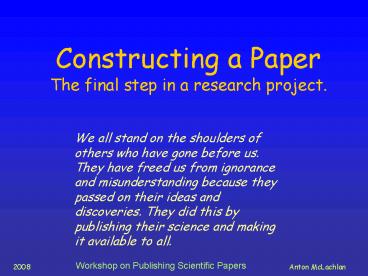Workshop on Publishing Scientific Papers PowerPoint PPT Presentation
1 / 17
Title: Workshop on Publishing Scientific Papers
1
Workshop on Publishing Scientific Papers
Constructing a Paper The final step in a research
project.
We all stand on the shoulders of others who have
gone before us. They have freed us from ignorance
and misunderstanding because they passed on their
ideas and discoveries. They did this by
publishing their science and making it available
to all.
2
Paper Writing is
- Both an art and a science
- Hard work
- Difficult without good science
3
Good vs Bad Science
- Research starts with an idea, i.e. identifying a
problem to be addressed - Background knowledge is essential
- Theory driven vs empirical
- Hypothesis testing
- Descriptive vs experimental
- Pure vs applied
- Contributing new knowledge
4
Three Essential Skills
- Language
- Literature
- Methodology
- Testable hypotheses
- Correct techniques
- Appropriate instrumentation
- Reliable data capture
- Appropriate statistical analysis
5
Other Important Issues
- Before starting to write a paper it is
important to be aware of the need for - Drafting an outline
- Following the journal format
- Avoiding plagiarism
- Informal peer review before submission
- Accepting criticism
6
Contents
- Title
- Abstract
- Introduction
- Methods
- Results
- Discussion (conclusion)
- Acknowledgements
- References
7
Two General Approaches
- Slow and Detailed
- Proceeds methodically from start to finish
- Requires great concentration
- Needs quality time
- Quick and Dirty
- Quick and rough initial compilation
- Followed by several iterations
8
Writing Sequence
- Methods
- Results
- Discussion
- Introduction
- Abstract
- Title
or
- In sequence
9
Title
- Short
- Clear and complete
- Double barreled
Examples Sandy beach biodiversity (3) A study
of the macrofauna on sandy beaches in Oman
with special reference to the effects of latitude
(18) Sandy beach macrofauna diversity
latitudinal effects (6)
10
Abstract
- Introduce the problem
- Outline the approach/methods
- Give key results/data
- Main conclusions
11
Abstract
- Differences in macrofauna diversity between
temperate and tropical sandy beaches have not
been clearly defined in the literature.
Quantitative transect surveys were used to
estimate macrofauna biodiversity on 10 tropical
beaches in Oman. Diversity recorded per beach
ranged from 20 to 30 species, with peracarid
crustaceans dominant. Diversity was negatively
correlated with both sand particle size and beach
slope. Comparison with similar beaches from
higher latitudes indicates significantly higher
diversity on these tropical beaches. This study
confirms higher diversity of beach macrofauna at
lower latitudes.
12
Introduction
- An introduction does three things
- Introduces the topic
- Covers key background literature to identify the
problem to be addressed - States the aims, i.e. how the problem will be
addressed
13
Introduction
- Beaches dominate the worlds and the Omani
coastlines. Macrofauna consists of molluscs,
crustaceans and polychaetes. Macrofauna
abundance and diversity varies in response to
physical factors sand, wave and tide regimes. - Some debate on the role of latitude. Studies
ignoring beach type find greater diversity at
high latitudes. Others claim this is an effect of
physical factors. This needs to be resolved by
considering both latitude and physical factors. - This project aims to separate latitudinal and
physical effects by sampling 10 beaches over a
range of types in the tropics and comparing them
to similar beaches in temperate areas.
14
Methods
- Methods must be repeatable
- Sequence is from field to lab to computer
- Study site
- Field methods
- Lab techniques
- Statistical analysis of the data
15
Results
- Results are
- Presented in the same sequence as in the methods
- Explained in terms of basic trends and
statistical significance
16
Discussion
- Discussion has three elements
- Interprets results in context of current
knowledge (literature) - Debates relevant theory
- Suggests future approaches
- Tip tie the last paragraph of the discussion
(conclusions) back to the introduction
17
Paper Writing - Conclusions
- This is a personal thing, many methods
- Not easy, takes effort and planning
- We keep learning cant buy experience
- Knowledge of literature essential
- Peer review is critical
- Work with experienced colleagues

